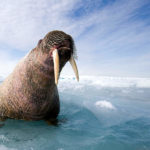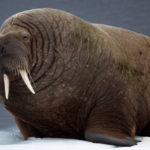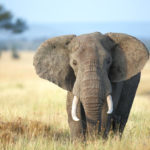Walruses
 Walruses are one of the largest pinnipeds of marine mammals. Males reach up to 1,700 kg, females – up to 1,200 kg. Among the pinnipeds, walruses are inferior only to the sea elephants. Their fins are very flexible and resemble hands with 5 fingers. Walruses have a wide head, small eyes and are easy to recognize by two protruding tusks. Moreover, there are tusks both in males and females.
Walruses are one of the largest pinnipeds of marine mammals. Males reach up to 1,700 kg, females – up to 1,200 kg. Among the pinnipeds, walruses are inferior only to the sea elephants. Their fins are very flexible and resemble hands with 5 fingers. Walruses have a wide head, small eyes and are easy to recognize by two protruding tusks. Moreover, there are tusks both in males and females.
Walruses use their tusks during fights, they help protect themselves from predators, and also pull their powerful bodies out of the water onto the ice. The tusks of walruses are actually long canines, and each tooth weighs up to 5 kg.
The whiskers of the walruses are not the hair, but very sensitive tactile organs, something that resembles a cat’s mustache. Animals use them to search for food under water. They feed on the most diverse inhabitants of the ocean from shelf glaciers: mollusks, worms, snails, soft crabs, crawfish, shrimp, sea cucumbers, shells, and slowly moving fish. Some walruses can even hunt seals, small whales and sea birds, and sometimes also eat carrion.
Walruses have only two natural enemies: killer whale and polar bear. These predators mostly hunt young walruses. Walruses can often be noticed by tourists on the coast or on floating ice floes. They can stay underwater for up to 30 minutes before they need to inhale fresh air. On land walruses try to keep in large groups – from 10 to several thousand individuals.
Females begin to give offspring at the age of 7-8 years and usually give birth to only one calf every 3 years. Pregnancy lasts 15 months, and after birth the baby needs mother’s help for 2 more years. In the wild, walruses live about 30 years. Walruses require for life small ice shelf waters and icy Arctic and subarctic waters. The largest population of walruses lives in the Pacific Ocean. They spend the summer in the north of Alaska, and in winter – off the coast of Russia. Another walrus population, much smaller, is found in the Canadian Arctic.
Hunting for walruses was banned in Canada in the 1930s, and in the United States in the 1940s. Although the global number of walruses is still quite large, it is believed that it is constantly falling. According to some estimates, only about 250 thousand walruses live on the planet.
It is expected that climate change will have a serious negative impact on walrus populations, especially those living in the Pacific. If the ice becomes thinner and begins to disappear, walruses have less space to rest, they have to swim more. Researchers are working on projects to study the behavior of walruses in the face of climate change in the hope of learning more about their reactions and how they can be helped. Another problem for future walruses is that they have a rather large gap between generations – 21 years.



























